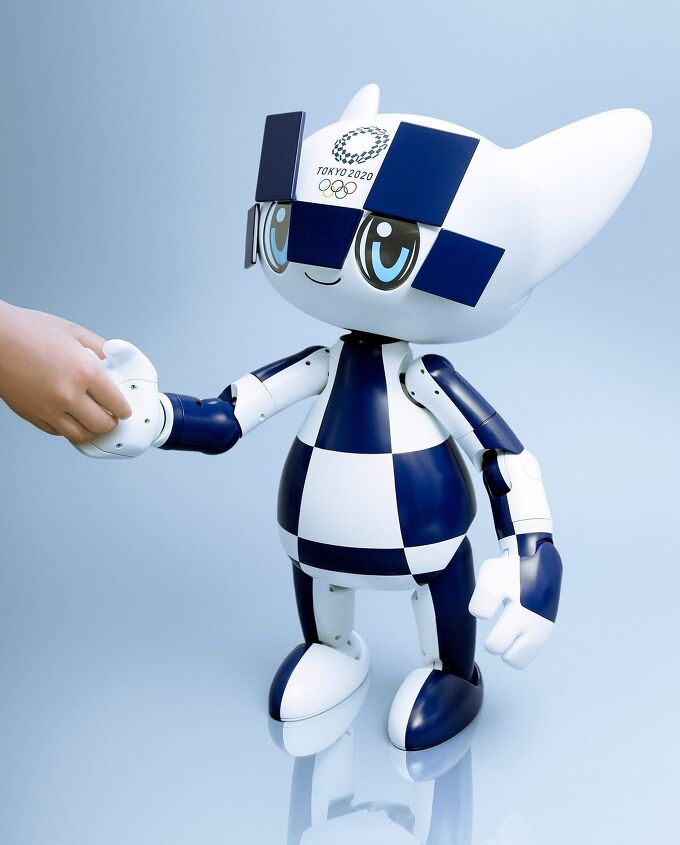Toyota's Doing Mobility Stuff – Some a Little Creepy, Rest Kind of Fun

When an automaker discusses mobility, they’re not really talking about anything specific. The term has been established within the industry as a catch-all phrase for electrification, app-based services, autonomous programs, data acquisition, robotics, and whatever other ideas that don’t fit neatly within a company’s core product line. Providing the best example of the term’s nebulous nature this week was Toyota, which showcased a glut of mobility projects for the 2020 Olympic and Paralympic Games — as well as toying with the idea of handing over vehicle data to the Japanese government.
Let’s start with the concerning aspects before we get into the goofy stuff.
On Tuesday, the Toyota Mobility Foundation said it would be holding a conference with the Akaiwa City, the Okayama Prefecture, Okayama University, and the local Akaiwa City Police to discuss the possibility of using connected-car data to inform decisions on road maintenance. While a worthy cause, the inclusion of the police suggests that won’t be the only potential usage of the data. We prattle on about the darker aspects of vehicular connectedness semi-regularly and, while we know it’s not as exciting as how much horsepower the new Corvette is going to have, these kinds of advancements are much more likely to impact your daily life in the coming years.
Toyota believes that giving the government the ability to tap into on-board camera systems and locational data could help save cities loads of cash by maximizing road maintenance effectiveness, but it also opens up a pandora’s box. It may not be their intent but automakers are making all kinds of moves that are help paving the road for worldwide surveillance. Between your internet history, smartphone data, and connected-car information, someone somewhere is always going to know what you’re doing at any given moment. And, while this wouldn’t be a big deal if we could implicitly trust every company and government across the globe, we know that’s ridiculous. At the very least, we hope Toyota takes its customers’ privacy into consideration during the meeting — someone certainly should.
The rest of Toyota’s mobility announcement served as a way to show off a little before the 2020 Olympics in Tokyo. Most of the products shown off were things we’ve items we’ve seen before but the company has been teasing a few new ones over the last few days. Angling for an inclusive and eco-friendly vibe with the “Mobility of All” tagline, the automaker brought up its fuel cell bus, autonomous e-Palette shuttle, a three-wheeled Segway-scooter knockoff (the “Walking Area BEV”), JPN taxi, a handful of robots ( some great), and its new APM (Accessible People Mover). The e-Palette and APM are both said to be on hand at the 2020 games to provide transport for athletes and fans while the rest will be available for consumers to ogle and/or interact with.
The brunt of these inventions seem mostly functional but a couple maned to coax out a smirk. Toyota’s FSR: Field Support Robot is an autonomous box that’s supposed to follow Olympic staff members to cart around javelins and shot puts. But the automaker’s promotional materials didn’t make it seem terribly impressive. There were also two horrendous robotic mascot designs (male and female) that lack the useful qualities of the service-based robots Toyota similarly plans on bringing to the event. The mascot robot uses a camera system to interact with attendees via a arm movements and various facial expressions.
However, my favorite new mobility project was the T-TR1 — because it was the funniest. Essentially a remote-controlled screen with cameras mounted on top, the device is supposed to allow individuals to access events that would be difficult to navigate with a wheelchair. This sounds like a wonderful idea until you’ve seen similar devices in action.
Years ago, I attended a trade event in San Diego and there were half a dozen iPads on sticks milling around. While the interface allowed you to speak with people, most of which were not disabled and simply wanted to try or promote the devices, they were hilariously clumsy. Their remote pilots sometimes disconnected or got hung up on carpeting, stranding the platform in the middle of a throughway, and had a habit of bumping into other patrons. Thankfully, their molasses-slow pace made physical encounters a minor inconvenience. The T-TR1 is larger and much faster, setting the stage for more memorable encounters. And, since the prototypes aren’t autonomous, expect to see at least one video of a T-TR1 slamming into something at the 2020 Olympics at full speed.
Toyota seems to be providing an even mix of useful technologies still in their infancy, go-nowhere applications, and disasters waiting to happen for the 2020 Olympics. While we’re more excited about the latter, the former inclusions should be commended — as mobility programs are rarely worthy of more than a shrug. It would have been nice to see them pushing more cars, however. The most auto-focused items to be featured in Tokyo next year are free rides in autonomous vehicles, a couple of old concept vehicles, and an appearance from the Toyota Mirai.
[Images: Toyota Motor Corp.]

A staunch consumer advocate tracking industry trends and regulation. Before joining TTAC, Matt spent a decade working for marketing and research firms based in NYC. Clients included several of the world’s largest automakers, global tire brands, and aftermarket part suppliers. Dissatisfied with the corporate world and resentful of having to wear suits everyday, he pivoted to writing about cars. Since then, that man has become an ardent supporter of the right-to-repair movement, been interviewed on the auto industry by national radio broadcasts, driven more rental cars than anyone ever should, participated in amateur rallying events, and received the requisite minimum training as sanctioned by the SCCA. Handy with a wrench, Matt grew up surrounded by Detroit auto workers and managed to get a pizza delivery job before he was legally eligible. He later found himself driving box trucks through Manhattan, guaranteeing future sympathy for actual truckers. He continues to conduct research pertaining to the automotive sector as an independent contractor and has since moved back to his native Michigan, closer to where the cars are born. A contrarian, Matt claims to prefer understeer — stating that front and all-wheel drive vehicles cater best to his driving style.
More by Matt Posky
Latest Car Reviews
Read moreLatest Product Reviews
Read moreRecent Comments
- THX1136 What happened to the other companies that were going to build charging stations? Maybe I'm not remembering clearly OR maybe the money the government gave them hasn't been applied to building some at this point. Sincere question/no snark.
- VoGhost ChatGPT, Review the following article from Automotive News: and create an 800 word essay summarizing the content. Then re-write the essay from the perspective of an ExxonMobil public relations executive looking to encourage the use of petroleum. Ensure the essay has biases that reinforce the views of my audience of elderly white Trump-loving Americans with minimal education. Then write a headline for the essay that will anger this audience and encourage them to read the article and add their own thoughts in the comments. Then use the publish routine to publish the essay under “news blog” using Matt Posky listing the author to completely subvert the purpose of The Truth About Cars.
- VoGhost Your source is a Posky editorial? Yikes.
- Fed65767768 Nice find. Had one in the early-80s; loved it but rust got to it big time.Still can't wrap my head around $22.5K for this with 106,000 km and sundry issues.Reluctant (but easy) CP.
- El scotto err not be an EV but to own an EV; too much training this week along the likes of what kind of tree would be if you were a tree? Sorry. Bring back the edit function.






































Comments
Join the conversation
Prattle on about privacy but it's a Brave New World. Just a few decades ago, nobody except a true visionary or an eccentric crank would have accepted the idea that people don't carry cash or submit their private information (credit card numbers for example) to somebody else in any version other than a paper trail. The time will come where "the benefits" of controlling traffic, tracking wayward spouses and other partners, monitoring policing effectiveness (and social applications) will be seen to be far more important that antiquated Revolution-era ideas about personal freedom and liberty. We're already halfway down that road anyway.
First things first, put Android Auto in your infotainment systems.